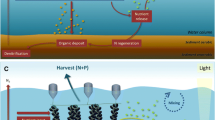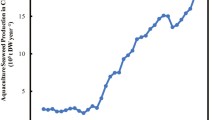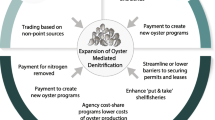Abstract
Bivalve shellfish play an important role in top-down control of primary symptoms of eutrophication. This short-circuits the process of organic decomposition and promotes an enhancement of underwater light climate, improved oxygenation of bottom water, and restoration of submerged aquatic vegetation. This review analyses this ecosystem service as a potential actor in watershed-level nutrient credit trading programmes and explores the possibilities of implementation of such programmes in Europe. We examine the different components of the issue, including the eutrophication status of European coastal waters, legal and management instruments, and the use of mathematical models at both the ecosystem and farm scales to evaluate the potential removal of nitrogen by cultivated shellfish such as oysters, mussels, and clams. The annual European bivalve shellfish production of over 700,000 metric tons is estimated to generate a nitrogen removal of 46,800 t year−1, equivalent to 14 × 106 population equivalent, and a minimum value of 507 × 106 €. We discuss future directions for this topic in Europe, drawing from ongoing research in the USA and elsewhere, in the light of the twin challenges of European aquaculture expansion and implementation of EU directives.




Similar content being viewed by others
Notes
This review focuses on nitrogen since it is generally the limiting nutrient for primary production in estuarine and coastal systems.
Defined as cultivation of different trophic levels at the system scale (e.g. embayment, fjord, estuary), promoting ecosystem services at that scale, rather than direct benefits from cultivation at close proximity (such as seen in ponds in Asia).
References
Bacher C, Duarte P, Ferreira JG, Heral M, Raillard O (1998) Assessment and comparison of the Marennes-Oleron Bay (France) and Carlingford Lough (Ireland) carrying capacity with ecosystem models. Aquat Ecol 31(4):379–394
Bayne BL, Newell RC (1983) Physiological energetics of marine molluscs. Academic Press, Mollusca, pp 407–515
Bayne BL, Iglesias JIP, Hawkins AJS, Navarro E, Heral M, Deslous-Paoli JM (1993) Feeding behaviour of the mussel Mytilus edulis. Responses to variations in quantity and organic content of the seston. J Mar Biol Ass UK 73:813–829
Borja A, Basset A, Bricker S, Dauvin J-C, Elliott M, Harrison T, Marques JC, Weisberg S, West R (2012) Classifying ecological quality and integrity of estuaries. Chapter 1.9 within the ‘Treatise on Estuarine and Coastal Science’ (Editors-in-Chief, Eric Wolanski & Donald McLusky), Elsevier. doi: 00109 is 10.1016/B978-0-12-374711-2.00109-1
Borja A, Bricker SB, Dauer DM, Demetriades NT, Ferreira João G, Forbes AT, Hutchings P, Jia i X, Kenchington R, Marques JC, Zhu C (2008) Overview of integrative tools and methods in assessing ecological integrity in estuarine and coastal systems worldwide. Mar Pollut Bull 56:1519–1537
Branosky E, Jones C, Selman M (2011) Comparison tables of state nutrient trading programs in the Chesapeake Bay Watershed. Washington, DC: World Resources Institute. http://www.wri.org/publication/comparison-tables-of-state-chesapeake-baynutrient-trading-programs
Breetz HL, Fisher-Vanden K, Jacobs H, Schary C (2005) Trust and communication: mechanisms for increasing farmers' participation in water quality trading. Land Econ 81(2):170–190
Bricker, SB, Ferreira JG, Zhu CB, Rose J, Galimany E, Wikfors G, Saurel C, Landeck-Miller R, Wands J, Trowbridge P, Grizzle R, Wellman K, Rheault R, Steinberg J, Jacob A, Davenport E, Tedesco M, Ayvazian S (2015) REServ: an ecosystem services assessment using bioextraction technologies for removal of nitrogen and other substances in long Island Sound and the Great Bay/Piscataqua Region. NOAA/EPA, (in press)
Bricker SB, Ferreira JG, Simas T (2003) An integrated methodology for assessment of estuarine trophic status. Ecol Model 169(1):39–60
Bricker S, Longstaff B, Dennison W, Jones A, Boicourt K, Wicks C, Woerner J (2007). Effects of nutrient enrichment in the nation’s estuaries: a decade of change, national estuarine eutrophication assessment update. NOAA coastal ocean program decision analysis series No. 26. National Centers for Coastal Ocean Science, Silver Spring, MD. 322 pp http://ccma.nos.noaa.gov/publications/eutroupdate/
Chang B, Page F, Losier R, McCurdy E (2014) Organic enrichment at salmon farms in the Bay of Fundy, Canada: DEPOMOD predictions versus observed sediment sulfide concentrations. Aquac Environ Interact 5:185–208
Cheshuk BW, Purser GJ, Quintana R (2003) Integrated open-water mussel (Mytilus planulatus) and Atlantic salmon (Salmo salar) culture in Tasmania, Australia. Aquaculture 218:357–378
Clausen IB, Riisgård HU (1996) Growth, filtration and respiration in the mussel Mytilus edulis: no regulation of the filter-pump to nutritional needs. Mar Ecol Prog Ser 141:37–45
Connecticut Department of Environmental Protection (CT DEP) (2010) An incentive-based water quality trading program. The connecticut Department of Environmental Protection, Bureau of water protection and land reuse, Hartford, CT. 10 pp
Cranford PJ, Reid GK, Robinson SMC (2013) Open water integrated multi-trophic aquaculture: constraints on the effectiveness of mussels as an organic extractive component. Aquac Environ Interact 4:163–173
Dame RF, Prins TC (1998) Bivalve carrying capacity in coastal ecosystems. Aquat Ecol 31:409–421
DEFRA (2014) MAGIC GIS. http://magic.defra.gov.uk/MagicMap.aspx
Dolch T, Buschbaum C, Reise K (2013) Persisting intertidal seagrass beds in the northern Wadden Sea since the 1930s. J Sea Res 82:134–141
Dral ADG (1967) The movements of the latero-frontal cilia and the mechanism of particle retention in the mussel. Neth J Sea Res 3(3):391–422
Duarte CM, Conley DJ, Carstensen J, Sánchez-Camacho M (2008) Return to Neverland: shifting baselines affect eutrophication restoration targets. Estuar Coasts 32(1):29–36
Dutch Fish Product Board (DFPB) (2008) Fish facts mussels (Sept. 2008). http://www.pvis.nl/fileadmin/user_upload/pvis/Documenten/Verantwoorde_vis/Fish_facts_mussels.pdf
Eisma D (1986) Flocculation and de-flocculation of suspended matter in estuaries. Neth J Sea Res 20(2–3):183–199
European Union (2014) Regulation (EU) No 508/2014 of the European Parliament on the European maritime and fisheries fund. http://eur-lex.europa.eu/legal-content/EN/TXT/?uri=uriserv:OJ.L_.2014.149.01.0001.01.ENG
Eurostat (2014) Total fishery production—total all fishing areas. http://ec.europa.eu/eurostat
Eyre JWH (1925) The Oyster and the public health. Public Health 38:6–27
FAO (1999) Regional review on trends in aquaculture development—Europe. Food and Agricultural Organization of the United Nations, Fish Culture Research Institute, Szarvas, Hungary
FAO (2014) The State of world fisheries and aquaculture (SOFIA). FAO, Rome
Ferreira JG, Hawkins AJS, Monteiro P, Moore H, Service M, Pascoe PL, Ramos A, Sequeira A (2008) Integrated assessment of ecosystem-scale carrying capacity in shellfish growing areas. Aquaculture 275:138–151
Ferreira JG, Sequeira A, Hawkins AJS, Newton A, Nickell T, Pastres R, Forte J, Bodoy A, Bricker SB (2009) Analysis of coastal and offshore aquaculture: application of the FARM model to multiple systems and shellfish species. Aquaculture 292:129–138
Ferreira JG, Andersen JH, Borja A, Bricker SB, Camp J, Cardoso da Silva M, Garcés E, Heiskanen A-S, Christoph Humborg L, Ignatiades C, Lancelot A, Menesguen P, Tett N, Hoepffner U Claussen (2011) Indicators of human-induced eutrophication to assess the environmental status within the European marine strategy framework directive. Estuar Coast Shelf Sci 93:117–131
Ferreira JG, Saurel C, Ferreira JM (2012) Cultivation of gilthead bream in monoculture and integrated multi-trophic aquaculture. Analysis of production and environmental effects by means of the FARM model. Aquaculture 358–359(2012):23–34
Ferreira JG, Falconer L, Kittiwanich J, Ross L, Saurel C, Wellman K, Zhu CB, Suvanachai P (2014a) Analysis of production and environmental effects of Nile tilapia and white shrimp culture in Thailand. Aquaculture. doi:10.1016/j.aquaculture.2014.08.042
Ferreira JG, Saurel C, Lencarte Silva JD, Nunes JP, Vazquez F (2014b) Modelling of interactions between inshore and offshore aquaculture. Aquaculture 426:154–164
Filgueira R, Guyondet T, Comeau LA, Grant J (2014) A fully-spatial ecosystem-DEB model of oyster (Crassostrea virginica) carrying capacity in the Richibucto Estuary, Eastern Canada. J Mar Sys 136:42–54
Gangnery A, Bacher C, Buestel D (2004) Modelling oyster population dynamics in a Mediterranean coastal lagoon (Thau, France): sensitivity of marketable production to environmental conditions. Aquaculture 230:323–347
Gerritsen J, Holland AF, Irvine DE (1994) Suspension-feeding bivalves and the fate of primary production: an estuarine model applied to Chesapeake Bay. Estuaries 17(2):403–416
Giles H, Pilditch CA (2004) Effects of diet on sinking rates and erosion thresholds of mussel Perna canaliculus biodeposits. Mar Ecol Prog Ser 282:205–219
Grant J, Bacher C (1998) Comparative models of mussel bioenergetics and their validation at field culture sites. J Exp Mar Biol Ecol 219(1–2):21–44
Grant J, Curran KJ, Guyondet TL, Tita G, Bacher C, Koutitonsky V, Dowd M (2007) A box model of carrying capacity for suspended mussel aquaculture in Lagune de la Grande-Entrée, Iles-de-la-Madeleine. Québec Ecol Mod 200:193–206
Hawkins AJS, Duarte P, Fang JG, Pascoe PL, Zhang JH, Zhang XL, Zhu MY (2002) A functional model of responsive suspension-feeding and growth in bivalve shellfish, configured and validated for the scallop Chlamys farreri during culture in China. J Exp Mar Biol Ecol 281(1–2):13–40
Higgins CB, Stephenson K, Brown BL (2011) Nutrient bioassimilation capacity of aquacultured Oysters: quantification of an ecosystem service. J Environ Qual 40(1):271–277
Houle J, Roseen R, Ballestero T, Puls T, Sherrard J (2013) A comparison of maintenance cost, labor demands, and system performance for LID and conventional stormwater management. J Environ Eng 139:932–938
Inglis GJ, Hayden BJ, Ross AH (2000) An overview of factors affecting the carrying capacity of coastal embayments for mussel culture. National Institute of Water & Atmospheric Research (NIWA) Client Report CHC00/69, Christchurch
Jones C, Branosky E, Selman M, Perez M (2010) How nutrient trading could help restore the Chesapeake Bay. Washington, DC: World Resources Institute. http://www.wri.org/publication/how-nutrient-trading-could-help-restore-chesapeake-bay
Jørgensen CB, Larsen PS, Riisgård HU (1990) Effects of temperature on the mussel pump. Mar Ecol Prog Ser 64:89–97
Kellogg ML, Cornwell JC, Owens MS, Paynter KT (2013) Denitrification and nutrient assimilation on a restored oyster reef. Mar Ecol Prog Ser 480:1–19
Kellogg ML, Smyth AR, Luckenbach MW, Carmichael RH, Brown BL, Cornwell JC, Piehler MF, Owens MS, Dalrymple DJ, Higgins CB (2014) Use of oysters to mitigate eutrophication in coastal waters. Estuar Coast Shelf Sci 151:156–168
Lal H (2010) Nutrient credit trading- a market-based approach for improving water quality. In: Delgado JA, Follett RF (eds) Advances in nitrogen management for water quality. Soil and Water Conservation Society, Ankeny, IA, pp 344–361
Lander TR, Robinson SMC, MacDonald BA, Martini JD (2012) Enhanced growth rates and condition index of blue mussels (Mytilus edulis) held at Integrated Multitrophic aquaculture sites in the Bay of Fundy. J Shellfish Res 31:997–1007
Lander TR, Robinson SMC, MacDonald BA, Martin JD (2013) Characterization of the suspended organic particles released from salmon farms and their potential as a food supply for the suspension feeder, Mytilus edulis in integrated multi-trophic aquaculture (IMTA) systems. Aquaculture 406:160–171
Lindahl O, Hart R, Hernroth B, Kollberg S, Loo L, Olrog L, Rehnstam-Holm A (2005) Improving marine water quality by mussel farming: a profitable solution for Swedish Society. Ambio 34(2):131–138
Liutkus M, Robinson S, MacDonald B, Reid G (2012) Quantifying the effects of diet and mussel size on the biophysical properties of the blue mussel, Mytilus Spp., feces egested under simulated imta conditions. J Shellfish Res 31:69–77
Loosanoff VL, Tommers FD (1948) Effect of suspended silt and other substances on rate of feeding of oysters. Science 107:69–70
Loveland RE, Chu DSK (1969) Oxygen consumption and water movement in Mercenaria mercenaria. Comp Biochem Physiol 29(1):173–184
Mariola MJ (2012) Farmers, trust, and the market solution to water pollution: the role of social embeddedness in water quality trading. J Rural Stud 28:577–589
Navarrete-Mier F, Sanz-Lazaro C, Marin A (2010) Does bivalve mollusc polyculture reduce marine fin fish farming environmental impact? Aquaculture 306:101–107
Nobre AM, Ferreira JG, Nunes JP, Yan X, Bricker S, Corner R, Groom S, Gu H, Hawkins A, Hutson R, Lan D, Lencart e Silva JD, Pascoe P, Telfer T, Zhang X, Zhu M (2010) Assessment of coastal management options by means of multilayered ecosystem models. Estuar Coast Shelf Sci 87:43–62
Nunes JP, Ferreira JG, Bricker SB, O’Loan B, Dabrowski T, Dallaghan B, Hawkins AJS, O’Connor B, O’Carroll T (2011) Towards an ecosystem approach to aquaculture: assessment of sustainable shellfish cultivation at different scales of space, time and complexity. Aquaculture 315:369–383
Orton JH (1928) On rhythmic periods in shell-growth in O. edulis with a note on fattening. J Mar Biol Assoc 15:365–427
OSPAR, 2010. C.Moffat, R. Emmerson, A. Weiss, C. Symon, L. Dicks (Eds.) Quality status report 2010. OSPAR Commission, London
OSPAR Commission (2000) Quality status report 2000. OSPAR Commission, London. 108 + vii pp
Parsons GJ, Shumway SE, Kuenstner S, Gryska A (2002) Polyculture of sea scallops (Placopecten magellanicus) suspended from salmon cages. Aquacult Int 10:65–77
Peharda M, Zupan I, Bavcevic L, Frankic A, Klanjscek T (2007) Growth and condition index of mussel Mytilus galloprovincialis in experimental integrated aquaculture. Aquac Res 38:1714–1720
Petersen JK, Hasler B, Timmermann K, Nielsen P, Tørring DB, Larsen MM, Holmer M (2014) Mussels as a tool for mitigation of nutrients in the marine environment. Mar Pollut Bull 82:137–143
Piehler MF, Smyth AR (2011) Habitat-specific distinctions in estuarine denitrification affect both ecosystem function and services. Ecosphere 2(1):1–16
Piet G, Albella AJ, Aro E, Farrugio H, Lleonart J, Lordan C, Mesnil B, Petrakis G, Pusch C, Radu G, Rätz HJ (2010) Marine strategy framework directive—task group 3 report—commercially exploited fish and shellfish. JRC57750
Pollack JB, Yoskowitz D, Kim H-C, Montagna PA (2013) Role and value of nitrogen regulation provided by oysters (Crassostrea virginica) in the Mission-Aransas Estuary, Texas, USA. PLoS One 8:e65314
Raillard O, Ménesguen A (1994) An ecosystem box model for estimating the carrying capacity of a macrotidal shellfish system. Mar Ecol Prog Ser 115:117–130
Reid GK, Liutkus M, Robinson SMC, Chopin TR, Blair T et al (2009) A review of the biophysical properties of salmonid faeces: implications for aquaculture waste dispersal models and integrated multi-trophic aquaculture. Aquac Res 40:257–273
RIVM (2002) MINAS and Environment. Balance and Outlook, RIVM, Bilthoven, The Netherlands
Rose JM, Bricker SB, Ferreira JG (2015) Comparative analysis of modeled nitrogen removal by shellfish farms. Mar Pollut Bull 91(1):185–190
Sagert S, Krause Jensen D, Henriksen P, Rieling T, Schubert H (2005) Integrated ecological assessment of Danish Baltic Sea coastal areas by means of phytoplankton and macrophytobenthos. Estuar Coast Shelf Sci 63(1–2):109–118
Sara G, Zenone A, Tomasello A (2009) Growth of Mytilus galloprovincialis (mollusca, bivalvia) close to fish farms: a case of integrated multi-trophic aquaculture within the Tyrrhenian Sea. Hydrobiologia 636:129–136
Saurel C, Ferreira JG, Cheney D, Suhrbier A, Dewey B, Davis J, Cordell J (2014) Ecosystem goods and services from Manila clam culture in puget sound: a modelling analysis. Aquac Environ Interac 5:255–270
Šegvić-Bubić T, Grubišić L, Karaman N, Ticina V, Mišlov JK, Katavić I (2011) Damages on mussel farms potentially caused by fish predation—self service on the ropes? Aquaculture 319:497–504
Shumway SE, Cucci TL (1987) The effects of the toxic dinoflagellate Protogonyaulax tamarensis on the feeding and behaviour of bivalve molluscs. Aquat Toxicol 10(1):9–27
Silva C, Ferreira JG, Bricker SB, DelValls TA, Martín-Díaz ML, Yañez E (2011) Site selection for shellfish aquaculture by means of GIS and farm-scale models, with an emphasis on data-poor environments. Aquaculture 318:444–457
STAC (Chesapeake Bay Program Scientific and Technical Advisory Committee) (2013) Evaluation of the use of shellfish as a method of nutrient reduction in the Chesapeake Bay. STAC Publ. #13-005, Edgewater, MD. 65 pp
Stephenson K, Aultman S, Metcalfe T, Miller A (2010) An evaluation of nutrient nonpoint offset trading in Virginia: a role for agricultural nonpoint sources? Water Resour Res 46:W04519. doi:10.1029/2009WR008228
Taylor BE, Jamieson G, Carefoot TH (1992) Mussel culture in British Columbia: the influence of salmon farms on growth of Mytilus edulis. Aquaculture 108:51–66
Tenore KR, Dunstan WM (1973) Comparison of feeding and biodeposition of three bivalves at different food levels. Mar Biol 21:190–195
U.S. Environmental Protection Agency (2008) EPA water quality trading evaluation, final report. Washington, D.C
Vincenzi S, Caramori G, Rossi R, De Leo GA (2006) Estimating clam yield potential in the Sacca di Goro lagoon (Italy) by using a two-part conditional model. Aquaculture 261:1281–1291
Walker S, Selman M (2014) Addressing risk and uncertainty in water quality trading markets. Washington, DC: World Resources Institute. http://www.wri.org/sites/default/files/wri_issuebrief_uncertainty_3-9_final.pdf
Wong I (2014) GIS mapping on mussel culture. http://hz.nl/Documents/Delta%20Academy%20Applied%20Research%20Centre/IW_FinalReport.pdf
Acknowledgments
The authors acknowledge support from the EU IDREEM (FP7) and AQUASPACE (H2020) projects and from the EPA/NOAA RESERV project. We are additionally grateful to Shawn Robinson and Peter Cranford, DFO Canada, for text suggestions, and to all our colleagues on the various project teams mentioned above.
Author information
Authors and Affiliations
Corresponding author
Additional information
Guest editors: Elena Mente & Aad Smaal / European Aquaculture Development since 1993: The benefits of aquaculture to Europe and the perspectives of European aquaculture production.
Rights and permissions
About this article
Cite this article
Ferreira, J.G., Bricker, S.B. Goods and services of extensive aquaculture: shellfish culture and nutrient trading. Aquacult Int 24, 803–825 (2016). https://doi.org/10.1007/s10499-015-9949-9
Received:
Accepted:
Published:
Issue Date:
DOI: https://doi.org/10.1007/s10499-015-9949-9




